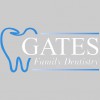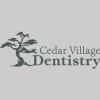
Originally started by Dr. John P. Gates in 1979, Gates Family Dentistry has now been serving the local community for over 40 years. Dr. Gates' vision was to establish a practice centered on quality dentistry and a positive experience for patients. Today, even after retiring in 2016, his vision thrives and is being continued by his son, Dr. Gregory Gates.
Throughout the years, the practice has undergone significant expansion and modernization to better serve our patients. This also has enabled a current, state-of-the-art dentistry experience for both patients and staff. Presently we have 2 dentists, 3 dental hygienists, 4 dental assistants, and 2 administrative assistants. We encourage you to visit the 'Our Team' and 'Meet the Dentists' pages of this website to get to know our dentists and staff.
Throughout the years, the practice has undergone significant expansion and modernization to better serve our patients. This also has enabled a current, state-of-the-art dentistry experience for both patients and staff. Presently we have 2 dentists, 3 dental hygienists, 4 dental assistants, and 2 administrative assistants. We encourage you to visit the 'Our Team' and 'Meet the Dentists' pages of this website to get to know our dentists and staff.
Services
She coordinates scheduling, insurance, communication with specialists/laboratories, and data entry.
She assists with scheduling, communication with specialists/laboratories, data entry, and sterilization.
Emily is our newest team member, joining in 2021, we are proud to welcome her to Gates Family Dentistry.
She is partially retired but still completes supply ordering, cleaning, and dental assisting as needed.
She assists with scheduling, communication with specialists/laboratories, data entry, and sterilization.
Emily is our newest team member, joining in 2021, we are proud to welcome her to Gates Family Dentistry.
She is partially retired but still completes supply ordering, cleaning, and dental assisting as needed.
A preventive program is a cooperative effort by the patient, dentist, and dental staff to preserve the natural dentition and supporting structures by preventing the onset, progress, and recurrence of dental diseases and conditions.
Preventing dental disease starts at home with good oral hygiene and a balanced diet.
It is continued in the dental office by the efforts of your dentist and dental hygienist to promote, restore, and maintain your oral health.
Prevention helps avoid serious and costly dental problems and is the key to having a healthy, confident, beautiful smile.
Preventing dental disease starts at home with good oral hygiene and a balanced diet.
It is continued in the dental office by the efforts of your dentist and dental hygienist to promote, restore, and maintain your oral health.
Prevention helps avoid serious and costly dental problems and is the key to having a healthy, confident, beautiful smile.
Intraoral cameras are changing the face of routine dental appointments.
The intraoral camera gives the patient a unique view of the mouth, enabling them to see and understand diagnoses, as well as make informed treatment decisions.
Utilizing intraoral cameras is a completely comfortable process for patients, and provides an honest assessment of the teeth.
Treatment planning - No matter how well a dentist might describe a condition, it is easier to understand the issue if it can be seen.
Seeing tooth decay and problem teeth helps patients understand why certain treatments are recommended for maximum health benefit.
The intraoral camera gives the patient a unique view of the mouth, enabling them to see and understand diagnoses, as well as make informed treatment decisions.
Utilizing intraoral cameras is a completely comfortable process for patients, and provides an honest assessment of the teeth.
Treatment planning - No matter how well a dentist might describe a condition, it is easier to understand the issue if it can be seen.
Seeing tooth decay and problem teeth helps patients understand why certain treatments are recommended for maximum health benefit.
Digital radiography (digital X-ray) is the latest technology used to take dental X-rays.
This technique uses an electronic sensor (instead of X-ray film) that captures and stores the digital image on a computer.
Digital X-rays reduce radiation 80-90% compared to the already low exposure of traditional dental X-rays.
Dental X-rays are essential, preventative, diagnostic tools that provide valuable information not visible during a regular dental exam.
Dentists and dental hygienists use this information to safely and accurately detect hidden dental abnormalities and complete an accurate treatment plan.
This technique uses an electronic sensor (instead of X-ray film) that captures and stores the digital image on a computer.
Digital X-rays reduce radiation 80-90% compared to the already low exposure of traditional dental X-rays.
Dental X-rays are essential, preventative, diagnostic tools that provide valuable information not visible during a regular dental exam.
Dentists and dental hygienists use this information to safely and accurately detect hidden dental abnormalities and complete an accurate treatment plan.
Panoramic X-rays (also known as Panorex(R) or orthopantomograms) are wraparound radiographs of the face and teeth.
They offer a view that would otherwise be invisible to the naked eye.
X-rays in general, expose hidden structures, such as wisdom teeth, reveal preliminary signs of cavities, and also show fractures and bone loss.
Unlike bitewing X-rays that need to be taken every few years, panoramic X-rays are generally only taken on an as-needed basis.
A panoramic X-ray is not conducted to give a detailed view of each tooth, but rather to provide a better view of the sinus areas, nasal areas and mandibular nerve.
They offer a view that would otherwise be invisible to the naked eye.
X-rays in general, expose hidden structures, such as wisdom teeth, reveal preliminary signs of cavities, and also show fractures and bone loss.
Unlike bitewing X-rays that need to be taken every few years, panoramic X-rays are generally only taken on an as-needed basis.
A panoramic X-ray is not conducted to give a detailed view of each tooth, but rather to provide a better view of the sinus areas, nasal areas and mandibular nerve.
Reviews

Be the first to review Gates, John P DDS.
Write a Review
